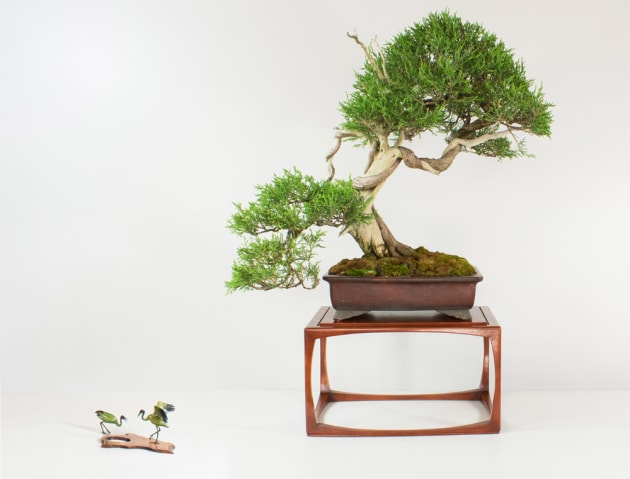Austin Heitzman: Featured Maker of the Year entrant
In 2022, Maker of the Year awards presented by Carbatec are open to makers all over the world. Austin Heitzman lives in Portland, Oregon, USA and is a self-taught woodworker who has a achieved a reputation for his creative designs, and in particular, his bonsai stands. As part of a series of features on this year's entrants we asked Austin a few questions about his work and creative priorities.
Who is Austin Heitzman and what was his path to becoming a woodworker?
I am self-taught as a woodworker. My formal education is in drawing and painting, however even then I worked more in three dimensions than two. I was first exposed to furniture after graduation while working at the Philadelphia Museum of Art as an art handler. The job allowed me intimate access to their extensive furniture collection and I took every chance I could to thoroughly examine each piece. I poured over books about furniture construction and understanding wood as a material. I set out to learn every tree by leaf, bark and lumber; I was hooked.
I first started making furniture for my own house, attempting to furnish it completely in five years, however that effort is still ongoing. As I built pieces for myself I began to get commissions from friends and then friends of friends. In 2011 my wife, a jeweller, and I decided to move to Portland, Oregon to pursue our craft full time. It’s been a hard road, but I’ve been a full time furniture maker ever since.
You have a particular flair for bonsai stands. Do you make stands to suit individual bonsai trees, or does it work the other way around?
Bonsai stands are exclusively used for indoor bonsai display. Bonsai trees must live outdoors year round and are only brought inside a few days at a time for display and competition. The tree is placed on a stand, which aesthetically pairs with the tree and acts essentially as an artful pedestal. Next to the tree, in the display, is a small accent plant on a thin slab, called a jita.
Combined, all the elements of a display are designed to conjure an imaginary landscape for the tree. Unlike traditional Japanese stands my bonsai stands are designed to be a more integral artistic element in the display, often this means designing a stand for one tree to create a specific vision. Mostly my work is done on commission, but I do occasionally make speculative stands, as in the case of the curved leg stand entered in this year’s MOTY.
Your bonsai stands are extraodinarily creative in form – what inspires you?
My inspirations are wide ranging. My bonsai work is inspired by both traditional Japanese and Chinese designs along with my own roots in American colonial furniture. My live edge work is obviously inspired by George Nakashima, but I also draw live edge inspiration from the Japanese art of suiseki.

Austin Heitzman, Liquor Cabinet
In suiseki, natural stones are displayed to evoke miniature natural vistas, like mountains, coastlines, waterfalls and such. I utilise natural edges as ornamentation sometimes evoking erosion and movement, other times echoing traditional furniture forms (like goose neck moulding as in my liquor cabinet from last year’s MOTY).
How long have you been making furniture? Do you make to commission, or do you sell through galleries?
I have been crafting furniture professionally for a little over a decade. My wife describes one’s “art” as the living you piece together making your artwork, everyone’s path is different. In addition to my bonsai stands I also craft custom furniture. I display my work at craft fairs and galleries across the western United States. I teach classes in my shop and give one-on-one private lessons, though covid temporarily paused my teaching. My wife and I also operate a studio building where we rent studio space to other artists and woodworkers. My web store features everything from T-shirts and boxes of my scrap wood to one of a kind pieces of furniture, and I’m proud of it all.

You seem fearless in your use of burl timbers – they can be difficult to work. What's your secret? What are your favourite timbers species?
Burl wood offers a fascinating universe of figure and countless opportunities for interesting natural edge, however its erratic grain structure can make it challenging to work. To combat this I prefer to work with my burl timbers from start to finish. I mill whole burls as wet as possible, as once they start to dry even a little they inevitably begin to break up. I mill with the grain, never cross grain ‘cookies’; I know these slices are popular but they are structurally weak and never dry well.
I prefer to mill large pieces thick, at least 2", in anticipation of a lot of movement during the drying process, better to have too much than too little material. The wood must also air dry slowly for at least two years before finishing in a kiln, if you rush this step I’ve found burls can honeycomb horribly. I like to mill lumber in the spring to give it a few months of higher humidity and ease it into our dry summer months, though this schedule would differ depending on your climate. Once dry the slabs need plenty of time to acclimate in the shop before surfacing begins, and I find it best to use multiple milling sessions to get it to the final thickness. Even with all this care success is not guaranteed, but that is what keeps things interesting.
At the moment elm burl is among my favorite species, the burl tends to be much redder than straight grain elm and I love the smell of the timber. Walnut burl is certainly the crowd favorite and a wonderful wood to work as well. I’m always on the hunt for something new and have milled rhododendron, redbud and apple to name just a few.

What's your long-term aim and what do you enjoy most about furniture and woodworking in general?
As interest in bonsai grows around the world I look forward to being a small part of its future. I find it’s easy for woodworkers to enjoy bonsai and vise versa, I love introducing each community to the other. Many of my classes are geared toward introducing bonsai artists to woodworking. I toy with the idea of writing a book on working with ‘character’ slabs and using live edge artfully, but my shop production keeps pushing this dream off. I taught classes pre-covid and look forward to a return to teaching as social interaction gets easier.

Every timber is unique and temperamental; the joy of discovery and the challenge of wood as a medium are what draws me to woodworking. I never get over the excitement when you first cut open a log. Each tree has the potential to grow a masterpiece, and finding that one-in-a-million log and seeing its beauty for the first time is a thrill beyond compare. I also love the extensive problem solving required to build something beautiful and useful from this amazing and unstable material.
See Austin's Maker of the Year entries here and here
Learn more at www.austinheitzmanfurniture.com and Instagram
Enter Maker of the Year presented by Carbatec at www.woodreview.com.au/moty2022
MAJOR SPONSOR


SUPPORTING SPONSORS






